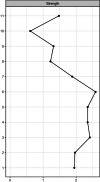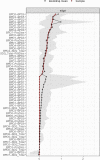Borderline personality disorder features and their relationship with trauma and dissociation in a sample of community health service users
- PMID: 37394448
- PMCID: PMC10316594
- DOI: 10.1186/s40479-023-00228-x
Borderline personality disorder features and their relationship with trauma and dissociation in a sample of community health service users
Abstract
Background: Previous studies have indicated that borderline personality disorder (BPD) is closely associated with trauma and dissociation. Nevertheless, BPD is a heterogeneous condition, and not all people with BPD have severe dissociation. This study examined whether the relationship of BPD features with trauma and dissociation would remain significant after controlling for some general non-specific mental health distress. We also made the first attempt to explore which specific BPD features would be particularly associated with dissociation.
Methods: We analyzed survey data from a sample of community health service users in Hong Kong (N = 376). Hierarchical multiple regression and data-driven network analysis were used.
Results: The lifetime prevalence of DSM-5 BPD was 16.0% in our sample. Of participants who met criteria for BPD, 43.3% scored above cutoff on the dissociation measures, thus possibly having clinically significant dissociative symptoms. BPD features were associated with adulthood trauma and psychoform dissociation even after controlling for age, depression and self-esteem. Network analysis showed that some BPD features - including impulsivity, identity disturbance and suicidal/self-mutilation behaviors - were particularly associated with dissociation; other BPD features such as interpersonal-related problems had relatively weak to no connection with dissociation.
Conclusions: Our results suggested that some particular BPD features might be dissociative in nature, although further longitudinal research is required. We argue that a trauma-informed perspective should be employed when working with clients presenting with BPD features despite these features being commonly stigmatized. Further research on the intervention needs of the people with BPD who suffer from high levels of dissociation is required.
Keywords: Borderline personality disorder (BPD); Comorbidity; Dissociation; Trauma; Trauma-informed care.
© 2023. The Author(s).
Conflict of interest statement
The authors declare no competing interests.
Figures
Similar articles
-
Dissociative Experiences, Borderline Personality Disorder Features, and Childhood Trauma: Generating Hypotheses from Data-Driven Network Analysis in an International Sample.J Trauma Dissociation. 2024 Jul-Sep;25(4):436-455. doi: 10.1080/15299732.2024.2323974. Epub 2024 Mar 18. J Trauma Dissociation. 2024. PMID: 38497592
-
Dysfunctional affect regulation in borderline personality disorder and in somatoform disorder.Eur J Psychotraumatol. 2012;3. doi: 10.3402/ejpt.v3i0.19566. Epub 2012 Sep 13. Eur J Psychotraumatol. 2012. PMID: 22984638 Free PMC article.
-
[Borderline personality disorder, self-mutilation and suicide: literature review].Encephale. 2008 Oct;34(5):452-8. doi: 10.1016/j.encep.2007.10.007. Epub 2008 Feb 20. Encephale. 2008. PMID: 19068333 Review. French.
-
Relationship of personality to dissociation and childhood trauma in borderline personality disorder.CNS Spectr. 2003 Oct;8(10):755-62. doi: 10.1017/s109285290001912x. CNS Spectr. 2003. PMID: 14712173
-
The extent of dissociation in borderline personality disorder: A meta-analytic review.J Trauma Dissociation. 2017 Jul-Sep;18(4):522-543. doi: 10.1080/15299732.2016.1240738. Epub 2016 Sep 28. J Trauma Dissociation. 2017. PMID: 27681284 Review.
Cited by
-
Components of event-related potentials and borderline personality disorder: a meta-analysis.Eur J Psychotraumatol. 2023;15(1):2297641. doi: 10.1080/20008066.2023.2297641. Epub 2024 Jan 12. Eur J Psychotraumatol. 2023. PMID: 38214169 Free PMC article. Review.
-
Diagnostic difficulty in an adolescent with dissociative identity disorder.S Afr J Psychiatr. 2025 Feb 12;31:2333. doi: 10.4102/sajpsychiatry.v31i0.2333. eCollection 2025. S Afr J Psychiatr. 2025. PMID: 40061578 Free PMC article.
-
A machine learning approach for differentiating bipolar disorder type II and borderline personality disorder using electroencephalography and cognitive abnormalities.PLoS One. 2024 Jun 21;19(6):e0303699. doi: 10.1371/journal.pone.0303699. eCollection 2024. PLoS One. 2024. PMID: 38905185 Free PMC article.
-
Trait dissociation in borderline personality disorder: influence on immediate therapy outcomes, follow-up assessments, and self-harm patterns.Eur J Psychotraumatol. 2025 Dec;16(1):2461965. doi: 10.1080/20008066.2025.2461965. Epub 2025 Mar 5. Eur J Psychotraumatol. 2025. PMID: 40042993 Free PMC article.
References
-
- American Psychiatric Association. Diagnostic and statistical manual of mental disorders (3rd ed). Arlington: Author; 1980.
-
- American Psychiatric Association . Diagnostic and statistical manual of mental disorders. 5. Washington, DC: Author; 2013.
LinkOut - more resources
Full Text Sources
Miscellaneous




